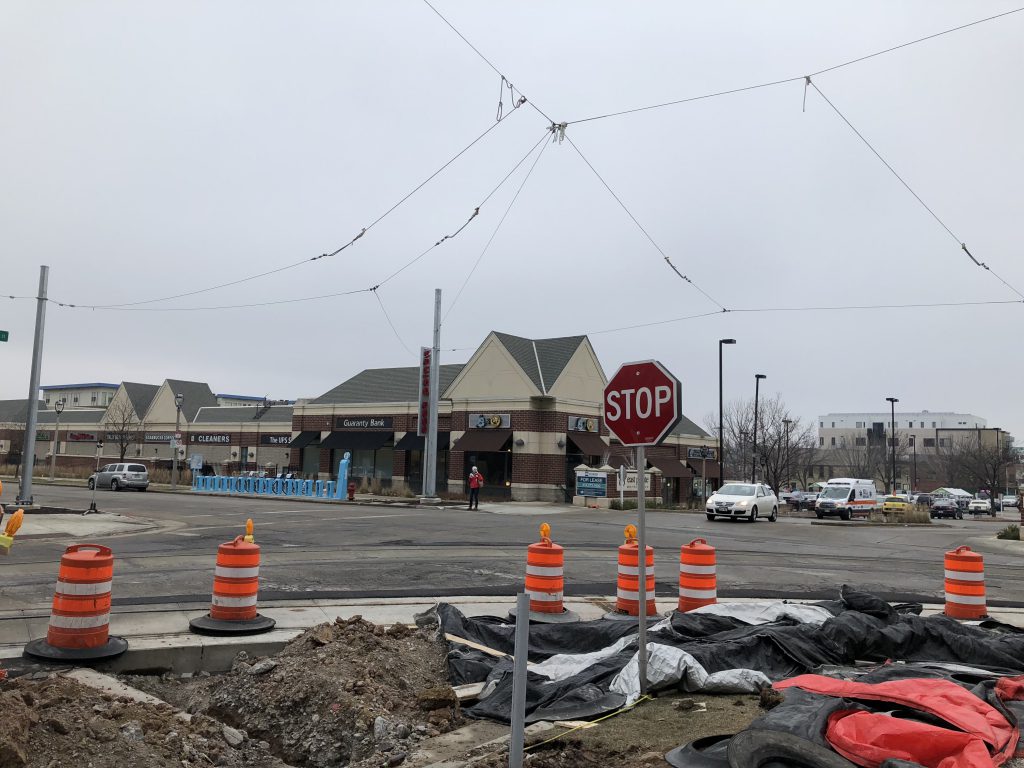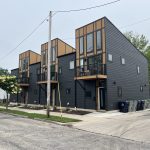$65 Million Spent on Streetcar
Construction of track is 90 percent complete, project ahead of schedule.

Work has started on the overhead contact system at E. Ogden Ave. and N. Jackson St. Photo by Jeramey Jannene.
Construction of the Milwaukee Streetcar is running ahead of schedule. Track work on the system’s first phase, which connects the Lower East Side, East Town, Historic Third Ward and Westown neighborhoods, is 90 percent complete according to the city. Construction on the $128 million system is being led by contractor Kiewet Infrastructure. The city has spent $65 million on the project so far.
The accelerated construction pace won’t result in the system opening earlier, but will result in fewer road closures and other disruptions for area residents and visitors in 2018. The only remaining track sections to be built include the segment crossing the St. Paul Bridge (scheduled for January) and sections of N. Milwaukee St. and E. Kilbourn Ave. (scheduled for spring as weather permits). Ten of the 17 station platforms have been completed.
The first phase of the system is scheduled to begin operating in late 2018, with the Lakefront Line coming online in late 2019.
The construction pace drew praise from Department of Public Works Commissioner Ghassan Korban, who said: “I do want to commend Kiewet and their construction team for completing a phenomenal amount of work in one season.”
City Engineer Jeff Polenske attributes the fast pace to the warm and dry fall weather. Track construction activity will drop off now that the temperature has fallen and ramp back up once weather permits.
Even with the cold weather, crews will still be busy installing the overhead contact system, which consists of poles and wire. This work is already nearing completion on E. Ogden Ave. Parking stalls are temporarily occupied by construction equipment while this work is underway.
Kiewet, in partnership with a number of local firms, is currently exceeding contract requirements regarding the hiring of unemployed or underemployed city residents. Through October 180 individuals participating in the city’s Resident Preference Program have completed 44 percent of the construction’s work hours. Kiewet is required to meet a 40 percent participation threshold.
Breakdown of Money Spent
It was Patrick J. Flaherty, who serves as the city’s owner’s representative in his role at The Concord Group, who informed the committee that $65 million has been spent on the project to date. The first two phases of the project have a combined budget of $128 million. The system is being funded in part by $68 million in federal grants.
Of the $65 million expended, $45.3 million has gone towards construction, $4.36 million for vehicles and $15.50 million for professional services. Nothing has been spent from the contingency fund.
Transdev, a multi-national private firm that won a competitive bidding process to operate and maintain the system, is developing all of the documentation required to train their staff. This includes standard operating procedures, maintenance plans and safety plans.
The city previously reported $30 million had been spent on the project as of May.
Vehicles Coming Soon
The delivery of the first streetcar vehicle from Brookville Equipment Corp. is expected to happen in early 2018. The company has a contracted delivery date in late February and appears to be on track, no pun intended, to meet that contract according to Polenske.
The city has ordered five vehicles to date. The first three are 50, 25 and 20 percent complete according to a city report. The city reports that members of the project team have been having bi-weekly meetings with the Pennsylvania-based manufacturer.
The vehicles will ultimately be stored in a yard under Interstate 794 in Westown. The yard is located immediately east of the Operations and Maintenance Facility that is being built along N. 5th St. That building, being constructed by CG Schmidt, is now sealed and heated. Construction on the building is expected to be complete in February.
Marketing RFP Due Soon
Firms looking to market the system have a busy Christmas and New Years holiday season ahead of them. Responses to a request for proposals are due on January 5th. The winning bidder will be involved in building out the brand for The Hop, as the system is planned to be called following a 12-year, $10 million Potawatomi Hotel & Casino sponsorship deal.
In an effort to keep the work local and in accordance with other contracts in the deal, 18 percent of the work must be completed by a certified Disadvantaged Business Enterprise. Alderwoman Milele A. Coggs, a proponent of the measure, confirmed that the DBE requirement was included in the contract.
For more on the RFP, see our November 20th column “Who Wants to Market the Streetcar?”
If you think stories like this are important, become a member of Urban Milwaukee and help support real independent journalism. Plus you get some cool added benefits, all detailed here.
More about the Milwaukee Streetcar
For more project details, including the project timeline, financing, route and possible extensions, see our extensive past coverage.
- Another Streetcar Collision - Jeramey Jannene - Jun 27th, 2025
- Streetcar Hit By Apparent Red Light Runner - Jeramey Jannene - Jun 16th, 2025
- Streetcar Will Run On Consolidated Route During Summerfest - Jeramey Jannene - Jun 11th, 2025
- City Hall: Milwaukee Must Replace Failing Streetcar Switches - Jeramey Jannene - Feb 24th, 2025
- Streetcar Confronts Limited Funding, Operations Challenges - Evan Casey - Jan 22nd, 2025
- Council Kills Streetcar’s ‘Festivals Line’ - Jeramey Jannene - Jul 31st, 2024
- Streetcar Will Use Festivals-Oriented Route Through Summer - Jeramey Jannene - Jul 9th, 2024
- The Hop’s Lines Will Merge For Easier Summerfest Service - Jeramey Jannene - May 30th, 2024
- Streetcar Begins Daily Service To The Couture, BRT Will Soon Follow - Jeramey Jannene - Apr 11th, 2024
- Milwaukee’s Three Streetcar Extensions Need Mayoral Direction - Jeramey Jannene - Nov 8th, 2023
Read more about Milwaukee Streetcar here
Eyes on Milwaukee
-
Church, Cupid Partner On Affordable Housing
 Dec 4th, 2023 by Jeramey Jannene
Dec 4th, 2023 by Jeramey Jannene
-
Downtown Building Sells For Nearly Twice Its Assessed Value
 Nov 12th, 2023 by Jeramey Jannene
Nov 12th, 2023 by Jeramey Jannene
-
Immigration Office Moving To 310W Building
 Oct 25th, 2023 by Jeramey Jannene
Oct 25th, 2023 by Jeramey Jannene
Transportation
-
MCTS Adds 28 New Buses
 Jul 13th, 2024 by Graham Kilmer
Jul 13th, 2024 by Graham Kilmer
-
MCTS Designing New Bus Shelters
 Jul 10th, 2024 by Graham Kilmer
Jul 10th, 2024 by Graham Kilmer
-
MCTS Updates RNC Bus Detours To Better Serve Downtown, Riders
 Jul 9th, 2024 by Jeramey Jannene
Jul 9th, 2024 by Jeramey Jannene





















Thank you on the update on this long needed transportation system that was approved by Congress during the early 1990s. It is a sad thing that so many trashed a huge opportunity then when the Federal funding was over $200 million and more than half was fritted away with congressional approval for bus replacements, and time erosion of the value of money.
Hate radio and ignorant people continually to this day, trash transportation upgrades that are the backbone of any successful society. It has been that way for thousands of years. Transportation is more than 1/3 of the US economy and engages in the movement of people, goods, services, and businesses and people that congregate and locate along their pathways and the hubs. All successful cities have various modes of transportation systems.
I love the concept of the streetcar, but I think it is being poorly done. Without dedicated lanes it’s pretty much a glorified bus.
TJ – more of the urban population is being priced out of car ownership with lower wage jobs. Fuel is cheap and abundant today, but will increase greatly in coming decades as China and India with greater Middle Classes strive to live like the US. The US is 4.7% of the planet’s population and consumes 25-40% of resources – a dead end pathway. It takes planning and vision for the future and the US is way behind where it could be.
The easy to access fossil energy has been used up on the planet. What remains has a higher price and is more destructive environmentally to access.
The current system is a starter. If it had gone as planned in the early 1990s, we could have had a more extensive system that stretched to the airport and Amtrak, the Zoo, and further north. If WI had taken the $800 million to expand Amtrak from Milwaukee to Madison and MN, we would have had connecting systems that are efficient and timely for users. Most tourists that visit cities use the train system.
Tourism brings in $17 Billion annually to WI. We need to increase opportunities for success. Most production industries have left Milwaukee. Like Allis Charmers, Nordberg, Allen Bradley, Master Lock, and are not coming back.
TJ, the streetcar will be faster and (ignoring one-time startup expenses) cheaper than any regular bus on the same route because:
• It can board and discharge passengers much faster at stops (step-free boarding, more and wider doors, no fare-box queue). Time wasted at stops (and red lights) is why MCTS averages only about 6 mph downtown.
• It can reverse direction at the end of its run much faster (no need to loop around the block waiting for traffic signals at each corner).
• While it has the same hourly operating cost as a bus (basically, the cost of a driver), it has at least triple the passenger capacity.
• It will have traffic signal priority at 9 key intersections.
It also does have some dedicated lanes:
• Milwaukee between St. Paul & Clybourn
• Michigan between Milwaukee and Cass
• Kilbourn between Milwaukee and Jackson
• 4th Street between St. Paul & Clybourn (end of line)
• Ogden between Farwell & Prospect (other end of line)
Thanks TransitRider – great reply